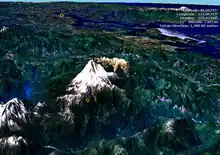Vertical exaggeration
Vertical exaggeration (VE) is a scale that is used in raised-relief maps, plans and technical drawings (cross section perspectives), in order to emphasize vertical features, which might be too small to identify relative to the horizontal scale.[1]

Scaling Factor
The vertical exaggeration is given by:
where VS is the vertical scale and HS is the horizontal scale, both given as representative fractions.
For example, if 1 centimetre (0.39 in) vertically represents 200 metres (660 ft) and 1 centimetre (0.39 in) horizontally represents 4,000 metres (13,000 ft), the vertical exaggeration, 20×, is given by:
- .
Vertical exaggeration is given as a number; for example 5× means vertical measurements appear 5 times greater than horizontal measurements. A value of 1× indicates that horizontal and vertical scales are identical, and is regarded as having "no vertical exaggeration." Vertical exaggerations less than 1 are not common, but would indicate a reduction in vertical scale (or, equivalently, a horizontal exaggeration).
Criticism

Some scientists[2] [3] object to vertical exaggeration as a tool that makes an oblique visualization dramatic at the cost of misleading the viewer about the true appearance of the landscape.
In some cases, if the vertical exaggeration is too high, the map reader may get confused.
References
- Introduction to Topographic Maps – Vertical Exaggeration
- David Morrison, "“Flat‐Venus Society” organizes", EOS, Volume 73, Issue 9, American Geophysical Union, 3 March 1992, p. 99. https://doi.org/10.1029/91EO00076. Retrieved 11 March 2019.
- Robert Simmon, "Elegant Figures What Not To Do: Vertical Exaggeration," NASA Earth Observatory, November 5, 2010. Retrieved 11 March 2019.